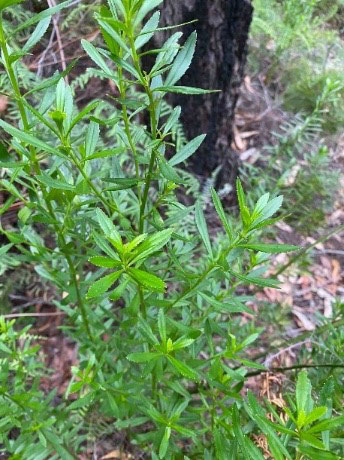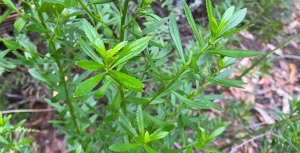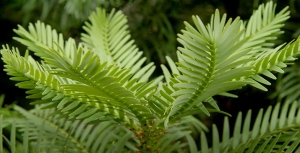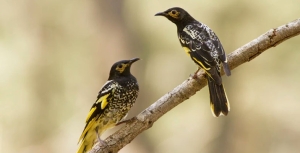Displaying items by tag: Assets of intergenerational significance
Some local AIS sites and the story of Hal
It is interesting to note that there are some local asset of intergenerational significance (AIS) sites protecting an unusual plant, Haloragodendron lucasii. There are four sites, one in Garigal National Park below Barra Brui Oval and three totalling about 300 ha in Ku-ring-gai Chase National Park in North Turramurra and St Ives. It is classified as endangered under both NSW and federal conservation legislation.
The Australian Plant Society reveals that H. lucasii was:
First recorded near ‘Gordon in a wild gully’ in 1908, five specimens of H. lucasii were held in the National Herbarium of NSW. The last specimen was collected in 1926, and following subsequent unsuccessful searches, the species was presumed extinct. That is until 1986 when the species was rediscovered at St Ives.
The rediscovered population was spread over a distance of at least 150 m along a terrace below the cliff line, and appeared to comprise several hundred plants growing among and out of a tangle of Gleichenia and Bauera. However, it was determined that the rediscovered population comprised only two plants. The first plant covered an area of 20 m2, with its underground stems giving the appearance of many separate plants. The second plant was even larger, spreading some 120 m along the terrace, but was discontinuous probably due to the effect of bushfires and the surrounding vegetation. It was, however, found to be a single individual or clone. More remarkable was that the plants were estimated to be 400 to 500 years old.
It was also established that the plants were sterile (i.e. produced no pollen). It was speculated that here was a remnant plant from an earlier era bound for extinction in the short term.
A further discovery effort was undertaken in 1997 by the NPWS, an ANU PhD student and Ku-ring-gai Council plus community volunteers. The story is told in this paper.
Over two flowering seasons three new populations of ‘Hal’ were found containing up to seven individuals. This doubled the number of known populations and genetic individuals. Still no fruit or seedlings were found so the verdict of sterility remains.

John Martyn has recently been on the hunt to spot these plants in North Turramurra. He described the ones he found as a maze of underground stems or runners that put up a small forest of suckers to around waist height. Its normal setting is below sandstone benches or drop-offs where it seems to like the runoff moisture.
But interestingly, at the site off the Bobbin Head trail there are three distinct sucker clusters that seem to me too far apart for an underground link. One is slightly downstream on a tiny creek line as if seeds (do they exist?) had washed down.
It seems there is more information to be discovered.
Assets of intergenerational significance – what are they?
The NSW Bushfire Inquiry recognised the need to identify the most important natural and cultural assets in the national park estate, so that special provision can be made for their conservation.
In 2020 the National Parks and Wildlife Act 1974 was amended to allow the Minister for the Environment to declare an area to be an Asset of Intergenerational Significance (AIS). An AIS can be any area of exceptional value – natural or cultural – that warrants special protection including dedicated management measures.
The first tranche of AIS is intended to protect the most important habitat for threatened species. Subsequent themes for AIS declarations may include nationally significant wetlands or important cultural heritage.
Potential declarations of environmental AIS will be informed by a range of considerations that include:
- sites for critically endangered, endangered, or vulnerable species
- important areas for breeding, feeding or shelter
- locations where locally extinct mammal species are being reintroduced
- where the national park otherwise provides important habitat
Opportunities to declare land in national parks as a cultural AIS will also be examined. Aboriginal communities will lead the process to determine areas with Aboriginal cultural heritage significance in national parks for declaration as cultural assets.
These cultural assets may include lands with tangible cultural heritage of importance to Aboriginal people, such as rock art, scar trees and middens. Protection may also be provided to intangible values, such as places of spiritual importance where storylines live on in the landscape and where significant cultural activities occurred and continue to take place.
What about those areas that will be flooded if Warragamba Dam is raised?
Conservation action plans
For each threatened species AIS, NPWS is under a statutory obligation to prepare and implement a concise conservation action plan (CAP) which sets out:
- key risks to the declared area of habitat for the threatened species
- priority actions to reduce risks to this important habitat – such as dedicated feral animal control or fire management, or the establishment of insurance populations
- actions to measure and report on the health/population of the threatened species (metrics)
In most cases, draft CAPs will be exhibited for public comment and advice sought from the National Parks and Wildlife Advisory Council.
The first declaration of an AIS was made in January 2021 for the Wollemi pine. In September the Environment Minister, Matt Kean announced a further 221 AIS sites that are habitat for 92 threatened species. They comprise 66 types of plants, 13 mammals, seven frogs, four birds and three reptiles. The 221 sites cover just over 300,000 hectares, or almost 4% of the national park estate. But national parks cover only about 9% of the state so the new protection is going to a very small proportion of the state.
Also he announced that the government has set a target of zero extinctions of native wildlife in the state’s national parks estate and an aim to improve and stabilise the status of threatened species. This will involve measures such as additions of land to the national park estate, creating a network of predator-free areas to support the return of locally extinct species (e.g. platypus in Royal National Park), consideration of threatened species in fire plans, feral animal control.
There is no mention of increased funding for all this activity.
This information comes from the Environment, Energy and Science Group which is part of the Department of Planning, Industry and Environment.
A Kean eye for extinction: minister’s ‘fortress’ for endangered species crumbles on closer inspection
Earlier this week, NSW Environment Minister Matt Kean claimed he was ‘fortressing’ threatened species from extinction within our national parks reserve system. His announcement was to declare 221 areas of threatened species habitat as Assets of Intergenerational Significance (AIS).
Great! Environment groups joined in congratulating Kean on his ‘intergenerational’ vision before looking at it in any detail.
I wanted to know what exactly the announcement was meant to achieve. The minister’s media headline sounded purposeful: ‘Zero extinctions targets set for NSW National Parks’. But how exactly did the announcement go that further step needed to protect our threatened species in National Parks? After all, aren’t National Parks established to be a ‘fortress’ against threatened species extinction in the first place?
On the day of the announcement, I could find little reference to the exact species or habitats that had been protected. I then asked around my contacts for the ministerial press release. Bingo – a small link in the PDF press release sent me to an online map. It is fair to say, what I stumbled across in that map shocked me.
The most threatened bird species in NSW is the critically endangered Regent Honeyeater. Its habitat in the Burragorang, Capertee and Hunter valleys were not listed as an ‘intergenerational asset’. A curious omission given the $1 million in funding the NSW government has thrown at the species over the past six years.
‘Threatened species fortress’: zero extinction goal for national parks
I then turned my attention to the Blue Mountains, an area where my family has spent decades bushwalking. One of the rarest eucalypt species in the Greater Blue Mountains World Heritage Area, the vulnerable Camden white gum, was also left off the list. There are only two known populations of the species left on the planet. Again, a very strange omission.
Then, in one corner of the Blue Mountains intergenerational asset map, I finally spotted two lesser-known endangered species that had been listed – the Kowmung hakea and Solanum armourense, tenacious little shrubs that grow in the depths of the southern Blue Mountains wilderness. Curiously, only one half of the population for each of these species had been declared an AIS.
I was starting to ask the question. How could such a well-instructed minister simply overlook these species and their known habitats?
It then dawned upon me that these species shared a common fate. Matt Kean’s government plans to flood their World Heritage National Park habitat by raising the Warragamba Dam wall. Indeed, it has been estimated that half the remaining global populations of both the Regent Honeyeater and the Camden White Gum will be drowned by the dam project. And the populations of those little endangered shrubs conveniently left off the intergenerational asset list are also set to go under.
The fact is, Kean has consigned these species to extinction by conveniently forgetting they exist in the very national park he is responsible for. It seems he has handed the control of the Blue Mountains National Park to Stuart Ayres, the Minister for Western Sydney – a man who has claimed the people advocating for the area’s protection in the face of his plans to raise Warragamba Dam wall, such as myself, are engaging in ‘environmental terrorism’.
The environmental movement should be calling out this announcement for the blatant political spin that it is. The devil is always in the detail – and the detail shows Matt Kean is sending some of Australia’s most iconic species towards extinction through what could be called his government’s own form of ‘environmental terrorism’.
This article was published in the Sydney Morning Herald on 10 September and is republished with permission from the author, Rob Pallin. Rob is the chairman of the Paddy Pallin Foundation, a board director of the Colong Foundation for Wilderness and a STEP member.
Postscript
Click here for a map of AIS. There are some noteworthy species on the list that are to be protected by these AIS declarations.
- There are several sites covering the critically endangered Southern Corroboree frog in Kosciuszko National Park. One questions how effective the conservation action can be when there is no effective plan to reduce feral horse numbers. One would have to be an insider in the NPWS to know if there are habitat sites outside the AIS sites that are badly affected by the horses so that these frogs will continue to lose suitable wetland habitats. The horses trample the sphagnum moss resulting in water draining away so that the streams dry out.
- There are several sites of koala habitat around the Port Macquarie area and further north in the AIS list. A more comprehensive method of meeting Kean’s objective of doubling the koala population by 2050 would be to adopt the proposal by the National Parks Association of creating the Great Koala National Park inland from Coffs Harbour. This land is currently state forest subject to intensive logging and has been badly affected by the 2019 bushfires. Private land clearing, particularly on the north coast, is a major factor in the decline of koala populations.
Will the improvement in numbers in the AIS sites make up for the continuing losses elsewhere?



